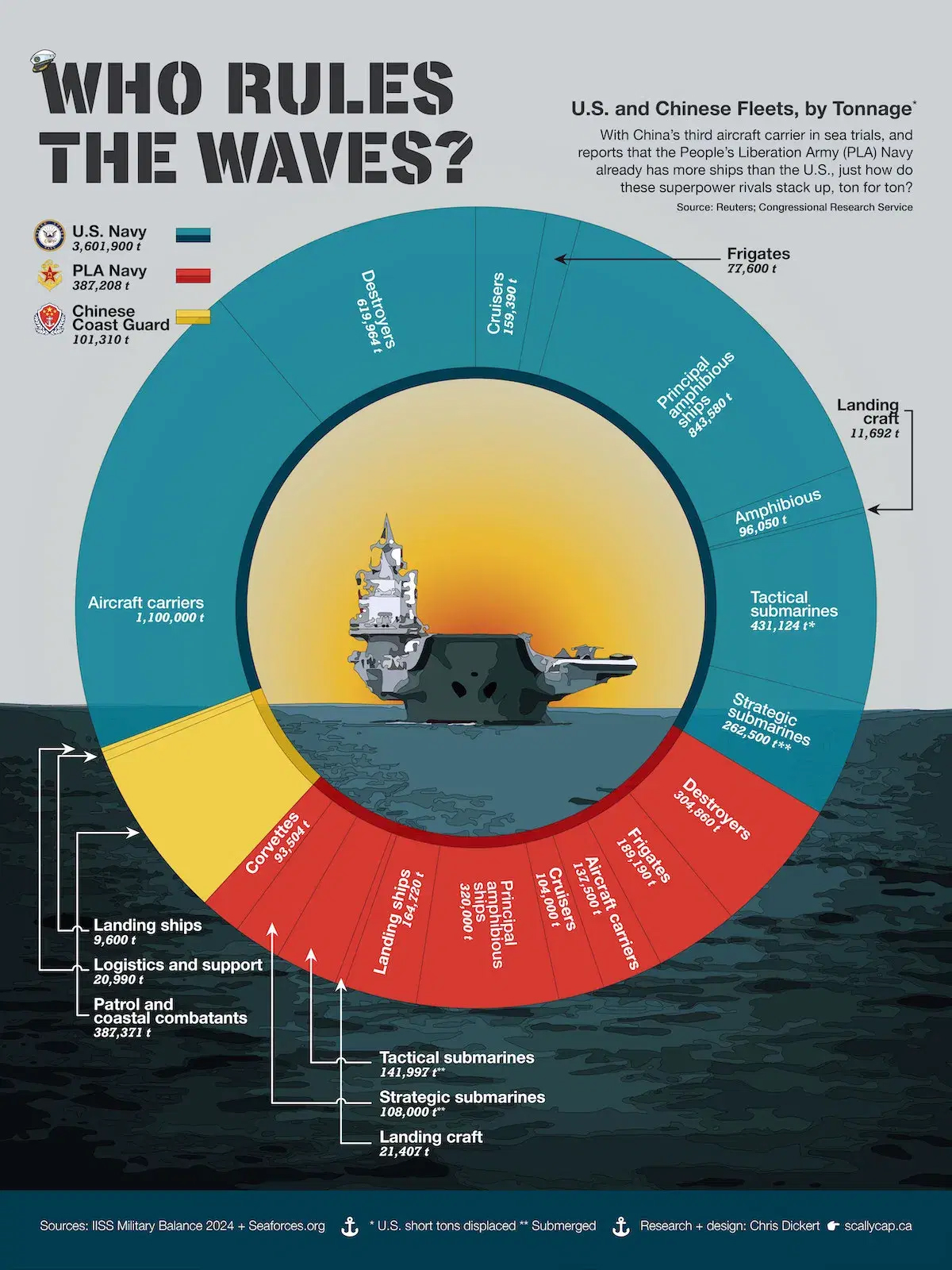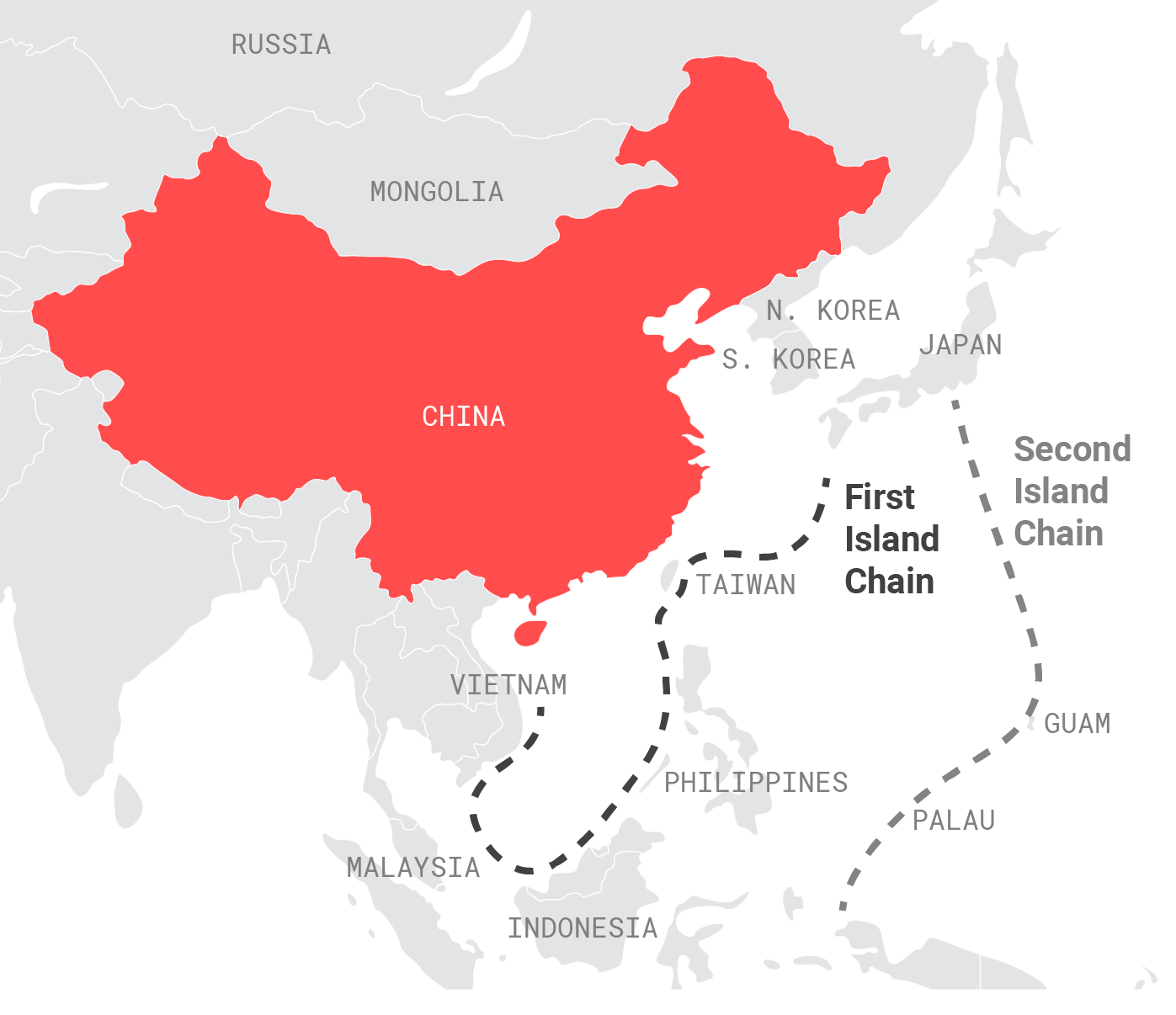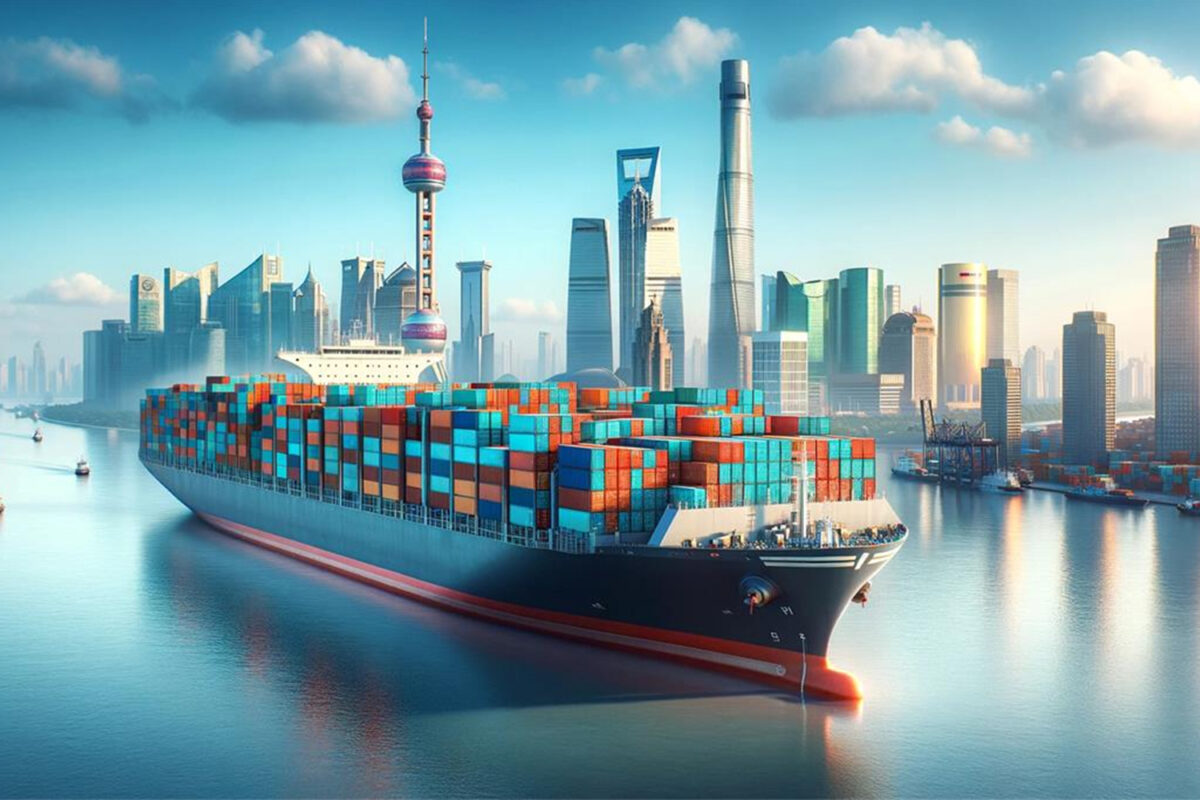
China’s third aircraft carrier recently began its sea trials, and there are reports that the People’s Liberation Army (PLA) Navy already has more ships than the US, but how do these rivals stack up?
Despite the advances in military technology sea power remains a key cog for any aspiring nation to be a global power. The British Empire’s dominance of the seas allowed her to maintain a global empire. Despite US technological superiority, its dominance of the oceans is what maintains her global status. As 90% of global trade is via the seas, whoever can provide security to the world’s oceans can influence the global economy. This is why America’s navy has been the key strategic weapon in its arsenal since its founding. For China, dominating its coastal waters and the sea’s adjacent to this have become a priority and this rapid development has worried many in the West.
If we look at the raw numbers, China boasts the largest number of ships, 1,015 between both the PLA Navy and the Chinese Coast Guard, against the US Navy’s 364. But the devil is in the details and this bean counting method doesn’t tell the whole story.
China’s military attracts a lot of media attention because the US was bogged down in two long wars in Iraq and Afghanistan. Numerous studies have been completed on the US vs China scenario and when China will eclipse the US. Much of the research has used a bean counting exercise comparing the number of ships or aircraft of both countries, but this exercise is very limited. When evaluating any force, you have to measure it against the mission it is trying to accomplish and the adversaries it may face and how it plans to resource and coordinate all its assets.
When evaluating any force, you have to measure it against the mission it is trying to accomplish and the adversaries it may face and how it plans to resource and coordinate all its assets
China’s naval doctrine is based on protecting its coastline and then expanding this area to give it security in its region. This has become known as anti-access, area-denial. This is why China’s military doctrine remains regional and not global, as this is where it expects threats to emerge. China sees the US as a potential adversary within its region due to its presence there. To resource this China realised it would need to develop its navy. In the past China prioritised its standing army and as a result it has reduced and replaced its old naval platforms with more modern ones. China’s doctrine is defensive, to protect what it has, it is not for offensive purposes. China’s military doctrine is the opposite to the US.
The US military doctrine is based upon the US projecting power globally to maintain its global presence. As the global superpower it needs to have enough military presence in every region to ensure no power can develop into a continental power and potentially challenge US global dominance. The US has to project force over great distances and as a result it resources this with over 800 military bases around the world and the world’s largest aircraft carrier group fleet. In fact, the US has long emphasised aircraft carriers, large surface combatants and a sizable fleet replenishment force that can project influence and force around the globe. The US military and naval doctrine is the complete opposite to China’s.
The vast difference between both countries’ navies can be seen if we use tonnage rather than actual number of ships. Here the US Navy has 4.5 million (US) tons of ships in its fleet, twice the size of China’s combined fleet of just over 2 million tons. While China boasts the largest number of ships, 1,015 between both the PLA Navy and the Chinese Coast Guard, against the US Navy’s 364, they are generally smaller and less advanced than their US counterparts.
The vast majority of PLA Navy ships average 711 tons apiece and aren’t able to sail far from China’s coast. So, whilst China may have more ships than the US, this is because these are much smaller and less capable. China doesn’t plan to send these ships across the world but have them protect its coast and smaller ships achieve this purpose.
The US on the other hand has an average tonnage per ship of over 12,000 tons, with its aircraft carriers displacing over 1 million tons combined. These 11 aircraft carriers are nuclear powered and it’s what sets the US apart from the rest of the world. Alongside this the US operates the world’s most advanced submarines. Its 21 Virginia class, nuclear-powered submarines pose a particular problem for China, which is something it has been working on.
For China to project power beyond even its first island chain, which is between 500 miles – 1,000 miles. China needs air and maritime assets to do this. Submarines are vital for China for this as they offer China the most realistic and effective way to project military power far from its shores. While Beijing is in the process of building up a very capable surface fleet, it is not yet powerful enough to reliably break through the first island chain let alone dominate distant waters.
 China’s island dash-line strategy intends to build naval and broader military capabilities to dominate the island chains that surround China’s coastal waters. The first island chain is between 500– 1,000 miles that runs from Japan’s southern Islands, passing Taiwan down to the Philippines and Vietnam. The second island chain goes out to Guam and down to Indonesia. In order to deny access to an adversary in this strategy submarines are vital for China as they offer China the most realistic and effective way to project military power far from its shores. Despite having around 70 submarines only 12 of these are nuclear powered, the rest are all diesel-powered attack submarines. While diesel-electric submarines are well-suited for warfare within the first island chain, only nuclear submarines combine the stealth and the range necessary to engage in modern, long-distance operations. Nuclear submarines allow a navy to be at sea for longer periods due to nuclear propulsion. Chinese power projection capabilities are improving, but the PLN’s ability to control military events diminishes rapidly beyond the unrefuelled range of diesel submarines.
China’s island dash-line strategy intends to build naval and broader military capabilities to dominate the island chains that surround China’s coastal waters. The first island chain is between 500– 1,000 miles that runs from Japan’s southern Islands, passing Taiwan down to the Philippines and Vietnam. The second island chain goes out to Guam and down to Indonesia. In order to deny access to an adversary in this strategy submarines are vital for China as they offer China the most realistic and effective way to project military power far from its shores. Despite having around 70 submarines only 12 of these are nuclear powered, the rest are all diesel-powered attack submarines. While diesel-electric submarines are well-suited for warfare within the first island chain, only nuclear submarines combine the stealth and the range necessary to engage in modern, long-distance operations. Nuclear submarines allow a navy to be at sea for longer periods due to nuclear propulsion. Chinese power projection capabilities are improving, but the PLN’s ability to control military events diminishes rapidly beyond the unrefuelled range of diesel submarines.
A Russian warship recently made a visit to Cuba,[1] and it gained much attention from analysts and the global media. China’ ships have also made a few long-distance visits to Djibouti and this would all indicate that China’s reach is growing. But without bases dotted around the world, without a large fleet of replenishment ships these visits will just be just that, mere visits in calm waters. They would not be suitable or effective in a war scenario as a sustainable presence would be needed with a sizable fleet to project power.
The US Navy edges out the PLA Navy across almost class of ship. The one area China does hold a 16:1 edge in tonnage is of landing ships and craft. This reflects the Communist party’s stated policy goal of reunifying Taiwan with the mainland. This reflects China’s priority and focus remains in its waters and the island of Taiwan and this is why we cannot really compare the Chinese and American navies as they are both trying to do different things.
As China does not have a navy or military that will fight far from home, any conflict between the US and China would likely be in China’s region. In a conflict close to the Chinese mainland, China’s military would enjoy geographic and positional advantages, while the US would be required to successfully deploy its forces into the region. The geography of conflict is critical, and even short distances have a major impact on relative capabilities. Chinese power projection capabilities are improving, but the Chinese military’s ability to control military events diminishes rapidly beyond the unrefuelled range of diesel submarines. On the flip side the US will need time to build up a force of enough strength and concentrate them in the region in any war scenario.
[1] Why are Russian warships in Cuba? | Russia-Ukraine war News | Al Jazeera




